David Suzuki's Blog, page 7
June 15, 2017
Trump is a pariah in the face of climate crisis

(Credit: Matt Johnson via Flickr)
In withdrawing from the Paris Agreement, U.S. President Donald Trump demonstrated monumental ignorance about climate change and the agreement itself. As Vox energy and climate writer David Roberts noted about Trump's announcement, "It is a remarkable address, in its own way, in that virtually every passage contains something false or misleading."
From absurd claims that the voluntary agreement will impose "draconian financial and economic burdens" on the U.S. to petty, irrational fears that it confers advantages to other countries to the misguided notion that it can and should be renegotiated, Trump is either misinformed or lying.
The agreement to limit global temperature increases that every country except Syria and Nicaragua signed in December 2015 (the latter because it doesn't go far enough!) is an astonishing achievement. Despite a relentless, massively funded campaign of denial, the world's nations came together and agreed to reduce the risk of climate chaos.
Scientists warn of overshoot, of exceeding greenhouse gas emissions beyond a level to which human society can adapt. As global average temperature rises, warming ocean waters could release immense amounts of methane frozen in Arctic waters. The potent greenhouse gas could take us into unknown territory where human survival is questionable. With Trump's single-minded focus on propping up outdated, polluting industries, he's unlikely to lead us out of this mess -- but that doesn't mean we should give up hope.
In science fiction stories about aliens invading Earth, the U.S. president gets on the phone with Russian, Chinese, European and other leaders. They unite to confront a threat that endangers them all. National borders mean nothing to the common enemy.
Today, we face a threat not only to our species but also to much of life on the planet. This time, the invasion isn't from outer space; it's the result of the collective effects of human activity. It still requires united effort to head off its most dire effects. Climate change and our response to it will be the defining moment of humanity's relatively brief history.
Human boundaries around property, cities, provinces and countries matter enormously to us but mean nothing to nature. Salmon, monarch butterflies, grizzly bears, air and water pay no attention to borders. In 1986, when fire broke out in Chernobyl, Ukraine, Swedish scientists were the first to alert the world to a catastrophic release of radioactive particles. Debris from the 2011 tsunami at Fukushima, Japan, reached Canada more than a year later. Although constructs like the economy, markets and corporations have huge significance for human affairs, their perpetuation depends entirely on the state of the biosphere.
Life on Earth was made possible by the blanket of greenhouse gases enveloping the planet. They regulated temperature and kept it from fluctuating drastically between day and night and through seasons. As life evolved, photosynthesis became the planet's primary means of capturing and using the sun's energy, eventually producing and maintaining atmospheric oxygen. Plants mediated the balance of carbon dioxide and oxygen, but the rise of fossil fuel-driven industrialization has pushed carbon dioxide beyond plants' capacities to utilize it. We have steadily altered the chemistry of the air beyond levels that developed over several million years.
Scientists have anticipated the crisis of catastrophic climate change from human activity for decades, but despite their warnings, political and economic agendas have, with a few exceptions, trumped real action to reduce fossil fuel use.
The problem didn't appear suddenly. Industrialized nations have been the major greenhouse gas contributors, spurred by the American economy's spectacular growth. Signatories to the Kyoto Protocol in 1997 recognized that countries responsible for the problem should cap and reduce their greenhouse gas emissions while allowing poorer nations to develop economically until leaders could enact another all-inclusive treaty.
If there's a bright side to Trump's decision, it's that climate change has received more serious media coverage than ever before, and people around the world -- from municipal, state and business leaders in the U.S. to heads of state everywhere -- have agreed to increase their efforts, to lead where Trump has failed.
People from all walks of life are joining forces to confront the common threat. The leader of the most powerful nation is not among them. Sad!
Hey! Want more DSF? Join David Suzuki on Facebook

Environmental Protection Act report could signal breakthrough for Canadian environmental law
OTTAWA -- A new federal government committee report recommends that the Canadian Environmental Protection Act (CEPA) be amended to recognize, respect and fulfil every person's right to a healthy environment. If passed by Parliament, this will be the first time in history that environmental rights have been recognized in Canadian federal law.
"This a breakthrough moment for Canada's growing environmental rights movement," said Ecojustice lawyer Kaitlyn Mitchell. "Environmental rights are human rights, and we applaud the committee for taking a clear, principled stance on the issue. This is a concept that transcends political lines and is fundamental to the advancement of a more just and equitable society."
The report echoes the message thousands of Canadians have recently sent to their elected officials in Ottawa: The law must meaningfully protect every person's right to a healthy environment, including clean air and safe water. The Standing Committee's report reflects this growing groundswell of support and is a crucial step toward enshrining those rights in federal law. The committee report includes more than 80 other wide-ranging recommendations aimed at improving CEPA.
"These recommendations, if implemented, could have major tangible benefits for the health and well-being of all Canadians, and ultimately save lives," said Peter Wood of the David Suzuki Foundation. "At least 15,000 Canadians die prematurely each year because of exposure to environmental hazards, and Canada ranks nearly last for environmental performance among the world's wealthiest countries. We urge Parliament to bring this into law as soon as possible so we can start to reverse these trends."
A recent study by the International Institute of Sustainable Development shows pollution costs Canada more than $39 billion annually. The report's recommendations could provide a pathway to reducing this economic impact.
In addition to calling for recognition of a substantive right to a healthy environment in CEPA, the report recommends major improvements to procedural rights provisions in the law, including the right to know about, participate in and challenge environmental decision-making.
It has been nearly 20 years since the Canadian Environmental Protection Act - the outdated federal law that regulates pollution and toxic chemicals - was last revised. It is currently under statutory review, creating a once-in-a-generation opportunity to significantly strengthen and modernize it to better protect human health and the environment.
Minister of Environment and Climate Change Catherine McKenna, and eventually Cabinet, will now consider the report. A bill is expected to be tabled in fall, with debate and voting to follow.
- 30 -
For media inquiries, please contact:
Kaitlyn Mitchell, Lawyer, Ecojustice
kmitchell@ecojustice.ca | 647-746-8702
Peter Wood, National Campaign Manager, David Suzuki Foundation
PWood@Davidsuzuki.org | 604-761-3075
Background
Ecojustice and the David Suzuki Foundation are partners in the Blue Dot Movement, a national campaign to advance the legal recognition of every Canadian's right to a healthy environment. Since 2014, thousands of Canadians have mobilized to urge their governments to take action in support of environmental rights. To date, 153 municipalities across Canada -- representing more than 40 per cent of Canada's population -- have passed declarations in support of the right to a healthy environment. There are 110 countries that recognize their citizens' right to a healthy environment, but not yet Canada.
Ecojustice, Canada's largest environmental law charity, uses the power of the law to defend nature, combat climate change and fight for a healthy environment for all.
The David Suzuki Foundation collaborates with Canadians from all walks of life, including government and business, to conserve our environment and find solutions that will create a sustainable Canada through science-based research, education and policy work.
Highlights of the report's recommendations
- Consumers should have the right to know if toxic substances are present in the goods they buy.
- Legal minimums should be established for air and water quality standards (currently there are only non-binding objectives).
- Require annual reporting on the state of Canada's environment, including environmental justice issues.
- Include special protections for vulnerable populations, including children, the elderly, First Nations and poor communities, in recognition that they are more likely to suffer from the effects of poor environmental health.
- Empower citizens to bring environmental civil actions, where government is found negligent in its duties, or when the Act is being violated.
- Provide greater resources to implement the Act.
Links and references
- The Report of the Standing Committee
- International Institute of Sustainable Development report on environmental health impacts of pollution
- Conference Board of Canada: How Canada Performs: Environment Report Card
Hey! Want more DSF? Join David Suzuki on Facebook

June 12, 2017
Cascades: Canada's first recycled paper products company

Cascades raw materials come from 84% recycled fibers.
Not so long ago, you couldn't buy anything made of recycled paper. Now companies turn waste into products people use every day.
I got the story behind Canada's Cascades from Mario Plourde, president and chief executive officer.
How was Cascades created?
In the 1950s, few people worried about the impact of mass consumption on the environment. As the dumps filled up, Antonio Lemaire wondered how to repurpose materials. In 1957, his family founded Drummond Pulp & Fibre, to recover waste and recycle pulp. Recognizing that old paper could be used to create new, Antonio and his sons bought an abandoned paper mill in Kingsey Falls, Quebec and founded Cascades in 1964.

What makes recycled paper products eco-friendly?
Paper and cardboard come from processing trees, using chemicals, energy and water. Recycling one product to make another reduces the pressure on natural resources. Our "forest" is urban -- it's in the recycling bin. Cascades recycles and works to improve methods and processes. We now use 2.7 times less energy and 6.5 times less water to manufacture our products than the average in the Canadian paper industry.
What's your biggest challenge?
People use less paper and now many companies manufacture paper and cardboard from 100 per cent recycled fibres, so there's greater demand for fewer raw materials. We prefer local suppliers to reduce transportation costs and related greenhouse gas emissions. But to ensure a stable supply of raw materials, we've expanded across North America.
What products do you make from recycled paper?
Toilet paper, paper towels, napkins and different types of packaging, from food containers and cardboard boxes to industrial packaging.
What else makes Cascades a "green" company?
Cascades has been named one of Canada's 50 best corporate citizens for the last 10 years and Quebec's most responsible company. In 2013, my predecessor, Alain Lemaire, was named Greenest CEO in Canada and earned Quebec's Green CEO Award. Cascades was the first company in its sector to put in a solar park to reduce natural gas consumption.
How can we make it easier for companies that use post-consumer paper?
A lot of packaging includes paper and plastic. Separate those when you put them in the recycling bin.
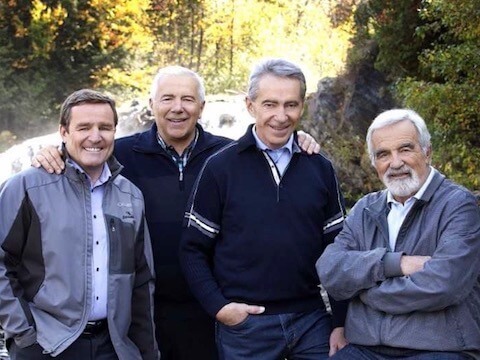
Are recycled paper products part of your life?
Sincerely,
Nikki Sanchez, a fellow Queen of Green
Hey! Want more DSF? Join David Suzuki on Facebook

June 8, 2017
Protecting oceans is paying off
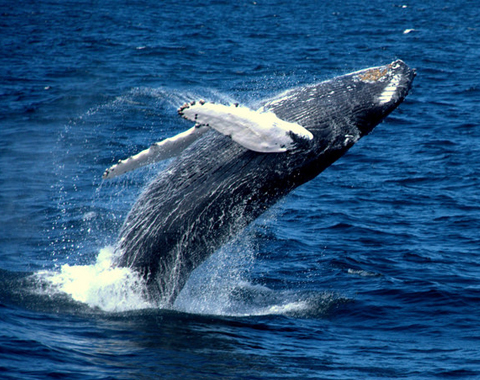
(Credit: Kevin Galens via Flickr)
Do you remember Harry Potter's invisibility cloak? It turns out wizards aren't the only ones who can vanish from sight with a special coat. Marine researchers have discovered shrimp-like crustaceans called hyperiids that can hide in the open using internal nanotechnology to cloak themselves in invisibility. That's just one among many fascinating discoveries to celebrate on World Oceans Day, June 8.
Last summer, scientists confirmed the elusive Greenland shark can live up to 400 years, beating out ancient bowhead whales and rougheye rockfish for the longest documented lifespan of any vertebrate. Researchers are just starting to learn about the two-metre, scale-free ragfish with cartilage skeleton and flabby flesh found in Alaskan waters, and the faceless fish found in Australian waters, whose eyes, gills and mouth are hidden.
That we're still discovering new wonders in the oceans is even more reason to protect them. We have a long way to go, though. In early 2016, about three per cent of oceans had formal protection from industrial activities, up from one per cent five years ago. Twenty countries, including Chile, Palau, the U.S. and the U.K., have committed to increasing marine protection.
Last summer's expansion of Hawaii's Papahānaumokuākea Marine National Monument created the world's largest marine protected area. In October, the Ross Sea -- home to some of the most productive waters in the Antarctic -- was finally declared a marine reserve after a decades-long push. When a coalition of 24 countries agreed to provide international protection for 1,548,812 square kilometres of the Southern Ocean, the Ross Sea surpassed Papahānaumokuākea as the largest marine reserve. Most impressively, Palau, part of Micronesia in the western Pacific, turned 80 per cent of its waters -- an area the size of California -- into a marine reserve. Britain established the Pitcairn Islands reserve in the South Pacific, a contiguous underwater park nearly the size of Pakistan.
In 2016, Prime Minister Justin Trudeau and then U.S. president Barack Obama issued a joint statement to "substantially surpass" international commitments to reach 10 per cent marine protection, even though Canada has protected less than one per cent so far. Our government is getting started, though. It announced strong protection for globally significant glass sponge reefs near B.C.'s Haida Gwaii earlier this year, ending years of inaction.
Along with increased ocean protection, new technologies are opening up ocean exploration. Researchers are adapting drones to track coastal erosion, map coral reefs, survey penguin populations, assess whale health and even learn about mysterious sea turtle behaviour. Thanks to a microscope that works underwater, scientists are learning how coral polyps interact and about patterns algae use to take over coral ecosystems.
Some jurisdictions are also getting serious about plastics that are choking seabirds, fish and marine mammals. California and Hawaii banned plastic grocery bags and some countries discourage use through taxation. In the U.S., Congress passed the Microbead-Free Waters Act to phase out tiny plastic microbeads in soaps, facial scrubs, toothpaste and other products by 2018. The United Nations Environment Programme is calling for a worldwide ban on products containing microplastics.
Protection efforts appear to be paying off. This year, the Committee on the Status of Endangered Wildlife in Canada down-listed shortfin mako sharks from "threatened" to "special concern". Around the world, anti-finning campaigns have helped decrease shark fin consumption. Endangered manatees made a comeback in the U.S., with Florida seeing a 500 per cent increase in the population, prompting the U.S. Fish and Wildlife Service to propose reclassifying them from "endangered" to "threatened".
Many whale populations are also rebounding after decades of commercial exploitation. Hunted to near extinction in the early 20th century, North Pacific humpback whales were recently reclassified from "endangered" to "special concern." Biologists estimate their population at 18,000.
Likewise, blue whales in the eastern North Pacific off California are showing signs of recovery, currently numbering about 2,000. Nearly exterminated by commercial whaling fleets before receiving worldwide protection in 1967, blue whales remain one of the rarest marine mammals, numbering between 10,000 and 25,000 worldwide.
Earth's oceans still face many overwhelming challenges and political obstacles, yet the resilience of nature and ecosystems is powerful. If we can rally around actions that protect rich ocean biodiversity, they can continue to provide an endless bounty of wonder and treasure.
Click here to tell the government to protect Canada's oceans
Hey! Want more DSF? Join David Suzuki on Facebook

Canada's ocean protection ripple could become a wave
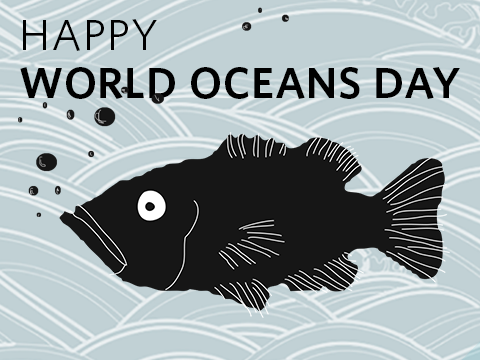
Twenty-five years after Canada proposed the idea of World Oceans Day to the United Nations, people around the world are still celebrating on June 8. It's also a time to reflect.
This week, a Canadian delegation is joining world leaders in New York to support the United Nations' goal to conserve and sustainably use the world's oceans, seas and marine resources. Canada borders three oceans and has the world's longest coastline, so marine protection should be central to our international reputation. A World Wildlife Fund poll shows 83 per cent of people in Canada are strongly in favour of protecting marine animals and habitats. Canadians expect their political representatives to keep orcas, belugas, salmon, sea otters, puffins and cod healthy.
Prime Minister Justin Trudeau appears to agree. In a 2016 joint statement with then-president Barack Obama, he committed Canada to "substantially surpass" international commitments to protect 10 per cent of our oceans. But our actions have fallen behind our commitments: Canada has protected less than one per cent of its ocean. Recent announcements about proposed protection for Arctic, Pacific and Atlantic waters are welcome signs of progress after decades of stalling.
Marine protection opportunities differ for each coast. On the Pacific Coast, natural features such as glass sponge reefs and marine mammal breeding grounds compete for space with an expanding list of human activities, including increasing oil tanker traffic, commercial fishing and eco-tourism operations. Strong provisions for globally significant glass sponge reefs near Haida Gwaii are a good start on the protection front, but proposed regulations for the Scott Islands -- a globally significant seabird area -- offer no new restrictions on fishing, shipping or other activities. Similarly, in the Atlantic, the soon-to-be designated Laurentian Channel marine protected area will prohibit fishing but allow oil and gas exploration. In the Arctic, Lancaster Sound provides protection opportunities. Moving ahead is essential as the effects of climate change in the region are dramatic, with warming ocean temperatures stressing northern ecosystems. Ice-free waters, new fisheries and more shipping traffic is making matters worse.
With reconciliation on many minds, Canada is required to engage with Indigenous peoples regarding their territorial waters and ensure free, prior and informed consent. When Indigenous people come together with communities, governments, ocean-based industries and other sectors, biodiversity gains from protection can be balanced with local sustainable development. An integrated management approach that brings together all ocean users to develop management plans for the entire ocean ensures that waters outside protected areas are also managed sustainably. These negotiations don't always happen on a level playing field, however, as powerful industry lobbyists can pressure government for concessions.
Although international marine protection standards prohibit mining, oil and gas development and industrial fisheries in marine protected areas, that's not always the case in Canada. Just as Canadians don't expect to see oil wells in Gros Morne National Park, the WWF poll shows that 90 per cent of Canadians support a ban on bottom trawling, mining and oil and gas development in marine protected areas. We must stop the double standard of accepting far less protection in marine environments than we do for our national parks.
Strong laws are essential to protecting marine life. The science is clear that marine protected areas require a set of minimum protection standards and effective protection must exclude industrial activities. The Oceans Act, which governs Canada's oceans and mandates their protection, must be equally clear: activities that compromise protected areas must be prohibited.
Canada is finally catching up with countries such as Australia and the U.S. by adopting environmental protection goals that support the United Nations' Convention on Biological Diversity's targets. We now have an opportunity to lead the world in creating effective marine protected areas. The government deserves kudos for finally committing to meet and exceed its 10 per cent target. However, scientists remind us that we must not sacrifice quality in the race to meet numbers. It's much more than the percentage that matters; it's how well these marine areas are designed, managed and monitored. Setting the bar too low in the push to meet targets and compromising on quality are short-sighted and don't serve Canada in the long term. If Canada wants to meet expectations at home and abroad, it must do more than draw lines on a map. It must protect the full array of marine life and biodiversity in protected areas.
Canadians value oceans and support the government taking steps to protect the marine environment. It's now up to the federal government to move forward with a stronger Oceans Act and support for marine protection that provides refuge for ocean creatures, ensures economic opportunities for local communities and respects the rights of Indigenous peoples. Now that Canada is finally creating marine protected areas, let's work hard to get it right. The world is watching.
If you're in Ottawa, join renowned photographer Cristina Mittermeier of SeaLegacy for Beneath Ocean Waves, a public event on Tuesday, June 13, from 6 to 8:30 p.m. at the Canadian Museum of Nature. To reserve your free ticket, please visit: http://bit.ly/beneathoceanwaves
Hey! Want more DSF? Join David Suzuki on Facebook

June 7, 2017
What's the deal with mobility pricing?
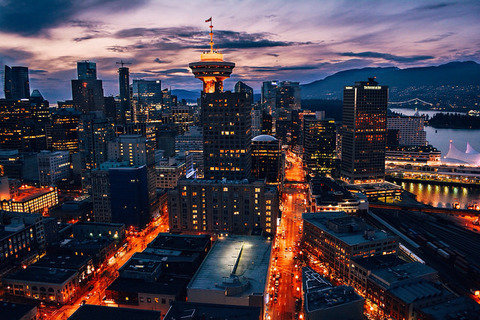
(Credit: Alex Costin via Flickr)
By Steve Kux, Renewable Energy and Climate Solutions Policy Analyst
On June 6, the Metro Vancouver Mayors' Council announced it will form an independent mobility pricing commission, prompting many people to ask, "What pricing?"
The short answer: mobility pricing is the approach a region takes to collect fees from residents, businesses and visitors for use of its transportation infrastructure. These fees can be collected through a variety of means -- ranging from transit fares to parking fees to bridge tolls to road pricing -- and the money collected is typically used to maintain and improve access to transportation.
A fair and reasonable approach to mobility pricing is important for any region, but it is particularly important in areas with rapidly growing populations and notable problems with traffic congestion, like Metro Vancouver. This is precisely what the new commission has been formed to advise on -- a fair and reasonable approach. Through consultations with the public and comprehensive research, the commission is expected to provide local policy-makers with recommendations that will ease the movement of people and goods throughout the region and ensure that all groups pay their fair share.
So, what might they recommend?
To do its job well, the commission will need to review how much people in Metro Vancouver pay for everything transportation-related -- from access to transit to hourly parking rates in downtown Vancouver. But the two most interesting things to consider are bridge tolls and road pricing.
Bridge tolls
Metro Vancouver employs a standard approach to bridge tolls: people who use the infrastructure pay a fee to recoup the cost of building the infrastructure in the first place. This method makes intuitive sense, but many would argue that it targets people who may have no choice but to use tolled routes -- forcing them alone to pay for upgrades that benefit the whole transportation network. After all, building a new bridge can certainly help ease congestion on other roads, to the benefit of users who never even use the new route.
During the recent B.C. election, bridge tolls were a hot topic. The B.C. Liberal Party pledged to cap the amount users could be charged in a given year while the B.C. NDP pledged to eliminate bridge tolls. Both of these commitments would affect provincial and regional revenue streams, forcing policy-makers to find ways to bridge the funding gap (if you'll pardon a terrible pun).
We can safely assume that the framework for tolling bridges will be a major focus of the mobility pricing commission's research.
Road pricing
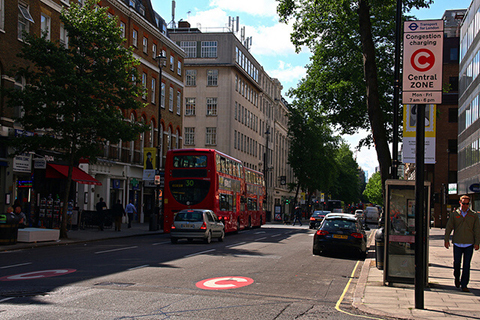
(Credit: Alain Rouiller via Flickr)
A new idea in Metro Vancouver is the concept of road pricing, which charges drivers a fee for accessing the road network. A number of approaches to road pricing could be used to raise the money to maintain the transportation network, but most can be placed into one of three buckets: corridor schemes, area schemes and full-network pricing.
Corridor schemes charge users a fee for accessing a particular piece of infrastructure. This should sound familiar, because bridge tolls are an example of a corridor scheme. Another corridor scheme already in use in Canada -- on a significantly larger scale -- is the toll system on Toronto's Highway 407.
Area schemes establish boundaries around particularly well-used blocks of roads and charge drivers who travel through the defined areas. A famous example is London, England's congestion charge, which tolls drivers entering the city's downtown core between 7 a.m. and 6 p.m. Stockholm, Singapore and Milan use various forms of congestion pricing to manage traffic and raise funds on their roads.
Finally, full-network pricing sets aside the idea of picking and choosing areas to charge fees for and simply charges users for access to the entire transportation system. This is typically accomplished by measuring the distance travelled and assigning a per-kilometre fee. The U.S. state of Oregon has experimented with this approach as a replacement for its gas tax.
What Metro Vancouver's mobility pricing commission might recommend is anyone's guess. Its work will focus on gathering data and opinions from across the region, as well as from around the world, and applying different ideas to the Metro Vancouver context. After that, it is up to policy-makers to take the information provided and make the best possible choices for keeping the region moving in the decades to come.
Hey! Want more DSF? Join David Suzuki on Facebook

June 5, 2017
Aquaculture Stewardship Council certified salmon isn't a "Good Alternative"
VANCOUVER/HALIFAX -- Today's decision by a renowned seafood recommendation program to label some eco-certified farmed salmon as a "Good Alternative" for consumers is faulty, according to SeaChoice, a collaboration among Canadian environmental groups. Seafood Watch published its recommendations today following a review of the Aquaculture Stewardship Council's (ASC) salmon certification standard.
"We're concerned that the salmon standard -- as evaluated by Seafood Watch -- is not being applied," says Kelly Roebuck, SeaChoice representative from the Living Oceans Society. "Every farm certified in Canada departs from the standard and requires variances to the ASC's environmental health requirements."
The Aquaculture Stewardship Council is a certification and labelling body for farmed seafood that manages global standards for responsible aquaculture.
Allowing variances to meet the sustainability criteria undermines the salmon standard. SeaChoice does not recognize ASC certified farmed salmon as a "Good Alternative" equivalent for consumers because Seafood Watch did not review these variances in its benchmarking process.
Canadian salmon farms are allowed variances in relation to the standard's sea lice indicator, which requires fish farm operators to control sea lice while wild juvenile salmon migrate nearby. The ASC now allows British Columbia farms to be certified with more than 60 times the number of lice permitted by the standard.
"We have always maintained that the regulation of sea lice in Canada is inadequate to protect wild fish, especially small juveniles as they begin their migration," said John Werring, senior policy analyst for the David Suzuki Foundation. "By allowing variances, ASC has diluted the value of its own standard to protect wild fish."
Elsewhere in the world, ASC has also approved variance requests that substantially alter the salmon standard in practice. For example, in Chile and Norway, chemical and drug use far exceeds prescribed limits. In Australia, benthic monitoring procedures have been changed in favour of local regulations.
"The ASC salmon standard was set up to be a global gold standard certification through a multi-stakeholder Salmon Aquaculture Dialogue. Now, four years into operations, the ASC is setting new rules that override the dialogue agreements without an appropriate scientific, transparent and inclusive process," Roebuck said.
SeaChoice is asking the ASC to repeal its variance request processes so that it can legitimately benchmark to a Seafood Watch "Good Alternative" recommendation.

- end -
Media contact:
Karen Wristen
Steering Committee Member, SeaChoice; Executive Director, Living Oceans Society
E: kwristen@livingoceans.org
P.: +1 (604) 788 5634 (Vancouver, Canada)
SeaChoice
SeaChoice is a collaboration between the Ecology Action Centre, David Suzuki Foundation and Living Oceans Society and has been working for over a decade to improve sustainable seafood purchasing policies among retailers across Canada, as well as to provide information to help consumers make sustainable seafood choices. SeaChoice is a member of the international Conservation Alliance for Seafood Solutions. SeaChoice member groups have been active stakeholders in the ASC and the Salmon Aquaculture Dialogues for more than a decade. This has included Steering Committee representation during the dialogue, membership in the Technical Advisory Group, the sea lice working group, as well as active stakeholder engagement on ASC audits and projects.
Further information on SeaChoice website: www.seachoice.org/seafood-recommendations/certifications/ and www.seachoice.org/improving-seafood-supply/ and www.seachoice.org/improving-seafood-supply/.
Backgrounder:
The ASC Salmon Standard
The ASC salmon standard was created in 2012 following a multi-stakeholder process known as the Salmon Aquaculture Dialogue. The standard is assessed by criteria to eliminate or minimize the environmental and social impacts of aquaculture. Version 1.1 of the standard was published in May 2017. Further information: www.asc-aqua.org.
ASC Variances and Process
Variance requests allow third-party auditors to seek an ASC interpretation of, or variance from, either a salmon standard criterion or auditor requirements. The variance request process can be used for any of the eight ASC standards. Of the 232 variance requests currently listed on the ASC website, as of May 17, 2017, 121 apply to the salmon standard alone.
The Monterey Bay Aquarium's Seafood Watch Benchmarking Exercise
Monterey Bay Aquarium's Seafood Watch program provides seafood recommendations based on the following rankings: "Best Choices", "Good Alternatives" and "Avoid". To determine which eco-certifications are consistent with at least a Seafood Watch "Good Alternative", the benchmarking exercise compares certification standards to the Seafood Watch methodology. The ASC Salmon Standard Version 1.1 was subject to this exercise and was deemed equivalent to at least a Seafood Watch "Good Alternative". No varied criteria of the ASC Salmon Standard were reviewed. Further information: www.seafoodwatch.org/seafood-recommendations/eco-certification.
Hey! Want more DSF? Join David Suzuki on Facebook

Ten ways to reduce your transportation footprint

A single city bus can take 40 private cars off the road and keep 168 tonnes of pollutants out of the air each year. (Credit: Canadian Pacific via Flickr)
According to Environment Canada, air pollution kills more than 5,000 people throughout the country every year. Public transportation helps fight urban air pollution.
A single city bus can take 40 private cars off the road and keep 168 tonnes of pollutants out of the air each year. A family with one car instead of two can reduce its annual emissions by 10 per cent!
Transportation produces more than 28 per cent of Canada's total greenhouse gas emissions. Unless we reverse some vehicle-use trends, these emissions will continue to rise.
Luckily, we have a range of options for getting around. Cities designed to encourage public (buses, trains) and active (walking, cycling) transportation help people and the environment stay healthy.
Reduce air travel: Four to nine per cent of humanity's total climate change impact is from air travel. Try a flying "fast", travel less, buy high-quality carbon offsets.
Make less garbage: When you fly, make your own waste-less travel kit. Say "no thank you" to single-use disposables during your trip.
Bike to work: Try bike to work dos and don'ts for a safe and fun commute. Sing, ride in the rain and learn how to avoid getting "doored"!
Carpool: Carpooling is a great way to reduce carbon emissions. It can also save time, money, and wear and tear on your vehicle, and lower the stress of daily driving.
Go idle-free: Stop idling. Consider starting your own campaign at your workplace or in your neighbourhood. Check out these resources to get started.
Commuter Challenge: Your workplace can join the Commuter Challenge each year in June. (Or organize it any time of year.)
Electric cars: Electric cars start at around $16,000 with a 110-kilometre range. EV owners report they're quiet, fun to drive and some models are charged and ready to go in as little as six minutes. Read our top FAQs, part one and part two!
Car-share: Many car sharers report a higher satisfaction with their quality of life, and drive about half the amount car owners do! Say goodbye to expenses such as vehicle purchase price, insurance, maintenance, fuel, tolls and parking.
Plan a block party: Celebrate community (and close your street to cars) this spring, summer or fall and meet the neighbours. Perhaps piggyback on existing Car Free day(s) events in your city.
Enjoy a staycation: Become a tourist in your city -- ride the train, visit area attractions or celebrate local food. Your kids may call you cheap, but you'll open their eyes to great things close to home.
What's your biggest hurdle when it comes to reducing your transportation footprint?
Sincerely,
Lindsay Coulter, a fellow Queen of Green
Hey! Want more DSF? Join David Suzuki on Facebook

June 1, 2017
Massey Tunnel's 10-lane bridge replacement doesn't fit equation for a cleaner, greener B.C.
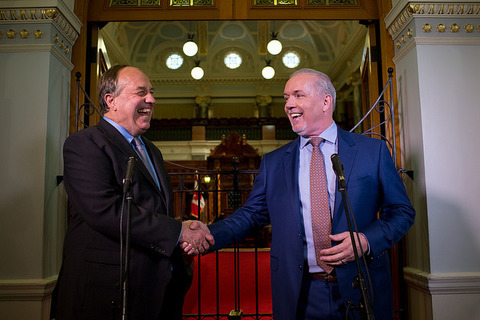
(Credit: BC NDP via Flickr)
By Winnie Hwo, Senior Public Engagement Specialist
Like many British Columbians, I have been following post-election developments closely.
On May 9, I voted for a healthy environment. For me, that means green transportation infrastructure and a clean energy future.
As a Lower Mainland resident, one of my top concerns is the Massey Tunnel bridge replacement. It's an issue that will not only have great influence on B.C.'s ability to meet its carbon-emissions reduction targets but will also determine my family's transportation means.
On Tuesday, I got a glimpse of what a cleaner and greener transportation future could look like, if the province moves in a new direction in which the environment and our well-being take centre stage.
According to the joint statement released by NDP leader John Horgan and Green Party leader Andrew Weaver, they hope to form a minority government that will expand B.C.'s carbon tax plan to an additional $5 per ton per year beginning April 1, 2018, and include taxation of fugitive emissions, including the fugitive methane gas released by the natural gas/fracking industry.
For us in the Lower Mainland, the promise to "act immediately to improve transit and transportation infrastructure in co-operation with the Mayor's Council and the federal government to reduce emissions, create jobs and get people home faster" is particularly important. It's a promise that, if carried through, will greatly improve my family's quality of life.
During the election, the B.C. Liberals campaigned on a plan to spend $3.5 billion on a 10-lane car bridge to connect the fastest-growing communities between South Fraser and Vancouver. However, as we add vehicles to the road, the prospect of building low-carbon public transit and transportation options for residents in this region dims.
In an op-ed published in the Province in late April, a group of Lower Mainland citizens considered how the B.C. Liberals' proposed bridge construction costs could be redirected. What alternative projects could this $3.5 billion fund? This is what they found:
1) $1.32 billion would add 750 hybrid buses to the Lower Mainland's fleet.
2) $1.3 billion would fund earthquake upgrades for 152 schools, allowing some to be replaced entirely.
3) $1.38 billion could build 5,520 affordable housing units.
More vehicles on the road means higher health-care costs. The province is well aware of this. Its website highlights that "vehicle emissions contribute to smog. The compounds in vehicle emissions are linked to respiratory and cardiovascular illnesses and are the most concentrated near major roadways in cities."
Experts confirm that B.C. is not on track to meet its legally binding emissions target put into law in 2008 -- requiring the province to reduce emissions by 33 per cent below 2007 levels by 2020. Instead, Christy Clark's government was aiming for a 2050 target with an 80 per cent reduction in emissions from 2007 levels. Adding vehicle capacity with a 10-lane bridge makes it far less likely that we'll meet these targets. Rather, they seem to be evaporating into thin air.
Clearly, there are many more worthwhile ways to spend this money, none of which would jeopardize our environment or the livability of our communities.
Both John Horgan and Andrew Weaver campaigned against the $4 billion, 10-lane bridge as a viable solution to the Massey Tunnel. Although the two leaders did not spell out their plans for a Massey Tunnel replacement in their latest announcement, I sincerely hope a cleaner alternative is in the works. With cooperation among parties and a new direction in government, British Columbians have a real chance to reboot and move toward a cleaner, greener future.
Hey! Want more DSF? Join David Suzuki on Facebook

World Environment Day reminds us to reconnect with nature
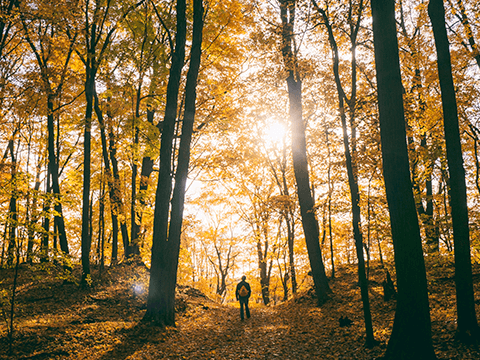
(Credit: Aaron Burden via Unsplash)
The notion that we must conquer or dominate nature has governed human behaviour for a relatively short period of our 150,000-year history on this 4.5-billion-year-old planet. It's an understandable impulse. Our intelligence and foresight allowed us to develop complex societies, and gave us a sense of control over our existence in the face of powerful, often threatening natural forces.
Unfortunately, our lack of attention to the intricate and interconnected ways of nature has led to widespread devastation that now threatens the very systems that support human health and survival. We have become disconnected from our own true nature.
The more science reveals about the natural world, the more we learn what many indigenous peoples have long known: that everything is interconnected and interdependent -- from the tiniest microbes to the largest carnivores, from plants that sequester carbon, prevent flooding and feed us to the carbon, hydrologic and other large cycles that keep the planet in balance.
There's no going back to simpler times, but our survival does depend on respecting our place in this miraculous world. To heal the disconnection, we must reconnect. It's fitting, then, that the theme of this year's World Environment Day on June 5 is "Connecting People to Nature."
Renowned American ecologist Edward O. Wilson used the term "biophilia" to describe the innate kinship people share with all other life forms. Because we are more likely to care for the things we love and see as important, we must rekindle this biological imperative if we are to protect the biosphere that keeps us healthy and alive.
How do we accomplish that when many of us are moving further from our natural connections daily -- when the average North American child spends less than 30 minutes a day playing outside, but more than seven hours in front of a TV, computer or smartphone screen, and when many adults spend their days driving to and from work where they sit in front of computers for hours on end?
Understanding the benefits of time in nature is a start. Studies show time outdoors can reduce stress and attention deficit disorder; boost immunity, energy levels and creativity; increase curiosity and problem-solving ability; improve physical fitness and coordination; and even reduce the likelihood of developing near-sightedness!
It also builds memories. I was fortunate in many ways to have grown up before televisions, computers, smartphones and other electronic distractions. My greatest memories are of fishing with my dad, exploring swamps and bogs to collect bugs, frogs and salamander eggs, and hiking in the mountains. Even the time my family spent in an internment camp in the British Columbia wilderness during the Second World War holds fond memories of playing by rivers filled with fish and exploring forests where wolves, bears and deer roamed.
In Japan, the term shinrin-yoku -- "forest bathing" or "taking in forest air" -- describes the beneficial effects of connecting with the natural world. Japanese researchers have found people who breathe forest air lower their risk for diabetes and experience improved mood and lower stress hormone production compared to people exercising on indoor treadmills.
Even getting dirty is good. In their upcoming book The Secret Life of Your Microbiome, Alan C. Logan and Susan L. Prescott explore the importance of microbes and microbiomes -- the microbial communities on and in our bodies and all around us. Microbes break down food and produce vitamins in our guts. They coat our skin, protecting us from attacks by harmful microbes. The air we breathe, the soil we dig and the outdoor plants we come into contact with include a variety of microbes -- many of them beneficial -- that may be absent in indoor and built environments.
Planting pollinator-friendly native plants in your garden, making a mud pie, taking photos of wildlife in the forest or sleeping under the stars are all healthy activities -- and they connect you with the natural world and open your eyes and heart to the amazing, intricately interconnected biosphere of which we are all a part.
Getting outside, especially with the children in your life, is one of the best things you can do for yourself, your family and friends, and the planet. World Environment Day reminds us of the importance of connecting with nature every day!
Hey! Want more DSF? Join David Suzuki on Facebook

David Suzuki's Blog
- David Suzuki's profile
- 247 followers



